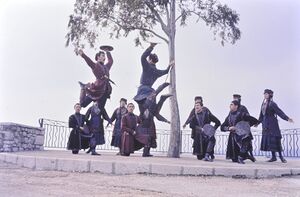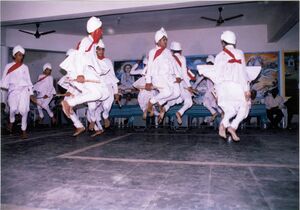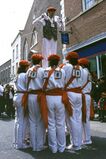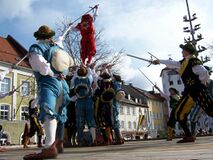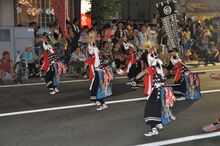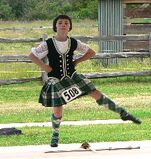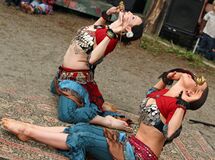رقصة السيوف
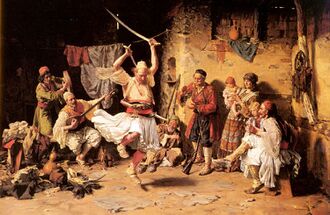
تم تسجيل رقصات السيوف التي تشتمل على السيوف أو الأسلحة المماثلة عبر تاريخ العالم.[1] هناك تقاليد مختلفة لرقصات السيف المنفردة والمعارك الوهمية (باهظة الثمن) في أفريقيا،[2] وآسيا[3] وأوروبا.[4] تستخدم بعض التقاليد العصي أو الهراوات بدلاً من الأسلحة البيضاء، بينما يستخدم معظم فناني الأداء الحديث النسخ المتماثلة لتجنب الإصابة.
النماذج
تشمل الأنواع العامة لرقصة السيف ما يلي:
- راقصون منفردون حول السيوف – مثل رقصات السيف الاسكتلندية التقليدية. يشمل هذا الشكل العام أيضًا رقصات غير السيف مثل رقصة أنابيب البكا في كوتسوولد رقصة موريس،[5]
- رقصات المعركة الوهمية، بما في ذلك العديد من رقصات العصا من التقاليد غير السيفية، والرقصات القارية الشائعة مثل Bouffons أو Mattachins كما وصفها Thoinot Arbeau في عام 1588.[6]
- hilt-and-point sword dances – where the dancers are linked together by their swords in a chain. These form the basis for rapper sword and long sword forms.[7]
الصين وفيتنام
Sword dances in China and Vietnam, known as jian wu or múa kiếm, began as a military training exercise with swords and spears which evolved into an elaborate acrobatic dance.[8] Jian wu was one of four classical dances that were used in the Chinese and Vietnamese opera. Each of these dances was very meaningful within the opera performances and they often were used for plot descriptions and characterization.[9] Sword dancing also found a use in Chinese and Vietnamese cultures through communicating with the supernatural; sword dancing was done in an effort to communicate feelings to the dead spirits that may be disrupting a household.[10]
There are quite a few styles within the actual art of sword dancing. The first style focuses on relaxation and flexibility while the other style focuses on speed and strength.[8] There are also different types of swords and weapons used during each dance. A long sword is usually wielded with slower dramatic movements during a solo performance while shorter scimitars are used at a very high pace during a sword dance between two or more people.[8] Each style requires certain movements that require the dancer to be highly agile and athletic.
جنوب آسيا
Many sword-dances in South Asia originated with the martial traditions of the region, the paragon of which exemplified in the long-established Gatka tradition, arising from the tenet of monolithic, theosophical militarization found within Sikhism. The paika akhada which were previously used to train Orissan warriors now perform weapon dances in the streets during festivals. Other dances like the mer dandiya are simply theatrical depictions of battle, while some like the choliya of the Kumaon region were used to ward off evil spirits. Sword dances are still commonly performed for weddings and other occasions in the Indian subcontinent today.
In the Indian subcontinent, the chhau sword dance,[11] Firkal sword dance,[12] Khasi tribal sword dance,[13] Bhotiya tribe sword dance,[14] Lakharu-li sword dance, Khaijama-Phanai sword dance, Gujarat sword dance and the Khattak sword dance are performed on festive occasions.[بحاجة لمصدر]
الشرق الأوسط
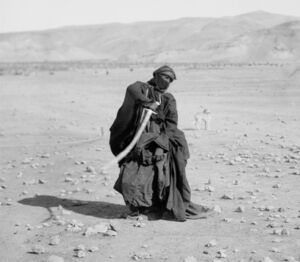
Arab sword dances (raqs al-saïf) evolved out of sword fighting between men, in both Egypt and Turkey. There was even a time when sword dancing was banned by the sultan during Ottoman rule, as it was believed that dancers, who took swords from soldiers and pretended to "kill" them at the end of the performances, collected the swords to begin a resistance against the army. These swords were never returned. Female sword dancing was not widespread in West Asia. Men in Egypt performed a dance called el ard, a martial dance involving upraised swords, but women were not widely known to use swords as props during their dancing in public. However, paintings and engravings by French artist Jean-Léon Gérôme (who visited Egypt in the 18th century) show sword dancers balancing sabers on their heads. The Turkish Kılıç Kalkan dance of Bursa is performed exclusively by men with a sword and shield, and represents the Ottoman conquest of the city. The performers wear early Ottoman battle dress and dance to the sound of clashing swords and shields without music.
أوروبا
Hilt-and-point sword dances are, or were, performed all over Europe. These are particularly concentrated in an area corresponding to the boundaries of the Holy Roman Empire at around 1400–1500, and many of these traditional dances are still performed in England,[15] Czech Republic, Germany, Austria, North Italy, France, Flanders, and the Iberian Peninsula, with a particular concentration in Basque Country, Galicia and Andalusia.[16][17]
Sword dances performed by the guilds of Smiths and Cutlers in Nuremberg are recorded from 1350. 16th century records of sword dances survive from all over Germany. Depictions of dances survive from Zürich (1578) and Nuremberg (1600). In Scotland a dance was recorded as being performed in 1285, but this was found in a document from 1440.
An important concentration of traditional sword dances can be found on the Italian side of the western Alps. Main sites are Giaglione, Venaus and S. Giorio in the Susa valley, where the so-called "Spadonari" (sword-holders) dance is still performed between the end of January and the beginning of February. This dance is also connected with the rebirth of nature and vegetation.
In Romania, in a dance called Căluș, a sword dance similar to a Morris Dance, is part of a more complex ritualistic dance involving elements of fertility ritual and horse worship.
Hilt-and-point sword dances traditional to England include rapper sword and long sword, although both of these are now also performed by revival teams outside their traditional areas, including teams in most of the English-speaking world. English sword dancing has also been brought to the New World, initially as part of the "morris revival" of the 1970s and 1980s. Teams are now extant in most major metropolitan areas in North America. The New York City Sword Ale is an annual gathering over Presidents' Day weekend that brings together over a dozen sword teams form the east coast and around the world.
The Rugova war dance[18] (ألبانية: Vallja me shpata e Rugovës or Loja Luftarake e Rugovës)[19] is a traditional Albanian sword dance named after the Rugova region[20] in Kosovo. The dance is considered a relic of the war dances (ألبانية: valle luftarake), the remnants of pantomimic dances performed in the re-enactment or preparation of battles.[20] The dance is performed by two male dancers who fight a mock battle for the hand of a girl (a "maiden's dance"[21]).[22]
معرض الصور
Markina sword dancers (Basque Country)
Traunstein Sword Dance (Germany, Bavaria)
Oni Kenbai (Devils Sword Dance) of Kitakami, Iwate, Japan
A young Highland dancer demonstrates a Scottish sword dance at the 2005 Bellingham (Washington) Highland Games
مرئيات
| عرض رقصة السيف للحرس الشركسي في عمان، الأردن. |
انظر أيضاً
الأدب
- Stephen D Corrsin, Sword Dancing in Europe: A History, London: Hisarlik Press (1997).
المصادر
- ^ "Dance History - The Sword Dance (Ghillie Callum)". www.toeandheel.com. Archived from the original on 2019-10-07. Retrieved 2019-10-07.
- ^ Taylor, Bayard (1862). A Journey to Central Africa: Or, Life and Landscapes from Egypt to the Negro Kingdoms of the White Nile (in الإنجليزية). G.P. Putnam and Son. p. 199.
sword dances, africa.
- ^ "Dances of Asia". KET Education (in الإنجليزية الأمريكية). Archived from the original on 2020-11-29. Retrieved 2019-10-07.
- ^ "Sword dance". Encyclopedia Britannica (in الإنجليزية). Archived from the original on 2020-06-08. Retrieved 2019-10-07.
- ^ "Longsword Dancing | The Morris Ring". themorrisring.org. 17 October 2011. Archived from the original on 2020-11-29. Retrieved 2019-10-07.
- ^ "Sword, Sabre, Rapier Dance History Archives - Main1". www.streetswing.com. Archived from the original on 2020-01-29. Retrieved 2019-10-07.
- ^ "Chasing the Star of Swords: Sword Dancing on a Watson Fellowship". Chasing the Star of Swords: Sword Dancing on a Watson Fellowship (in الإنجليزية). Archived from the original on 2020-11-29. Retrieved 2019-10-07.
- ^ أ ب ت Cohen, Selma Jean (1998). Cohen, Selma Jeanne (ed.). "China". The International Encyclopedia of Dance. 1: 382–386. doi:10.1093/acref/9780195173697.001.0001. ISBN 9780195173697. Retrieved 14 Oct 2012.
- ^ Pong, David (2009). "Dance". Encyclopedia of Modern China. 1: 382–386. Archived from the original on 29 November 2020. Retrieved 14 Oct 2012.
- ^ Sprenger, Guido (2010), "From Power to Value: Ranked Titles in an Egalitarian Society, Laos", The Journal of Asian Studies (ABI/INFORM Complete) 69 (2): 403–425, doi:, ProQuest 304250153
- ^ Devi, Ragini (1990). Dance dialects of India (2nd rev. ed.). Delhi: Motilal Banarsidass. ISBN 9788120806740. Retrieved 7 November 2016.
sword dance in india.
- ^ "The last frontier of Firkal martial art of Chotanagpur area – Jharkhand | Tribal Cultural Heritage in India Foundation". indiantribalheritage.org. Retrieved 2022-09-30.
- ^ Bareh, H. M., ed. (2001). Meghalaya (in الإنجليزية) (1. ed.). New Delhi: Mittal Publ. p. 99. ISBN 9788170997917. Retrieved 7 November 2016.
- ^ Massey, Reginald (2004). India's dances : their history, technique and repertoire (1. publ. in India. ed.). New Delhi: Abhinav Publ. p. 234. ISBN 9788170174349. Retrieved 7 November 2016.
- ^ Corrsin, Stephen D. (1997-01-01). Sword Dancing in Europe: A History (in الإنجليزية). Hisarlik Press. ISBN 9781874312253. Archived from the original on 2020-11-29. Retrieved 2019-12-08.
- ^ Pelinski, Ramón (2011). La danza de Todolella. Memoria, historia y usos políticos de la danza de espadas. Valencia: Institut Valencià. ISBN 9788448256548. Archived from the original on 2019-12-28. Retrieved 2017-03-17.
- ^ García Gallardo, F.; Arredondo, H. "DANZAS DE ESPADAS Y TOQUES DE TAMBORIL EN LA SIERRA Y EL ANDÉVALO ONUBENSES (PDF Download Available)". ResearchGate (in الإنجليزية). Archived from the original on 2020-11-29. Retrieved 2017-03-17.
- ^ Daubeny, Peter (1952). Stage by stage. J. Murray. p. 141.
THE WARRIOR DANCE OF RUGOVO.
- ^ Halimi, Kadri (1971). Vendi i Lojës së Rugovës në Vallet Luftarake Shqiptare [The place of the Rugova Dance in Albanian War Dances] (in الألبانية). Pristina.
{{cite book}}: CS1 maint: location missing publisher (link) - ^ أ ب UCLA Journal of Dance Ethnology. Vol. 13. UCLA Department of Dance. 1989. pp. 34–39.
- ^ Nebojša Tomašević (1968). Yugoslavia in Colour. "Review," Yugoslav Illustrated Monthly. p. 34.
- ^ Journal of the International Folk Music Council. Published with the assistance of the International Music Council, under the auspices of United Nations Educational Scientific and Cultural Organisation for the International Folk Music Council by W. Heffer. 1951.
A dance by two men of the Albanian minority from Rugova (Pec) represents a mock battle to obtain possession of a young girl.
وصلات خارجية
- Rapper Online - information on the rapper sword dance
- Overview of hilt-and-point sword dances (from Rapper Online; includes photos, videos and links)
- Feature Bavarian Sword Dance (Schwerttanz Traunstein, YouTube)
- Giaglione, Italy, sword dance
- Star Of Swords -Firsthand accounts on European Sword Dance from France, Italy, Spain, Basque Country and England
- Sword dances in Croatia
خطأ لوا في وحدة:Authority_control على السطر 278: attempt to call field '_showMessage' (a nil value).
- CS1 الإنجليزية الأمريكية-language sources (en-us)
- CS1 maint: location missing publisher
- CS1 الألبانية-language sources (sq)
- Short description matches Wikidata
- Articles with unsourced statements from January 2017
- Articles with hatnote templates targeting a nonexistent page
- Articles containing ألبانية-language text
- Pages using Lang-xx templates
- Pages with empty portal template
- War dances
- Mock combat
- Swordsmanship
- European dances
- Middle Eastern dances
- Asian dances
- Medieval dance
